May 29, 2025 | 12:00 GMT +7
May 29, 2025 | 12:00 GMT +7
Hotline: 0913.378.918
May 29, 2025 | 12:00 GMT +7
Hotline: 0913.378.918
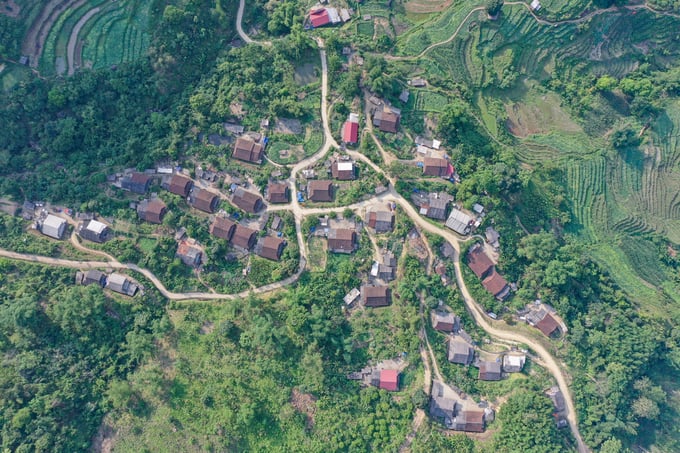
The village of Que Lam Dao people on the top of Pu Lau. Photo: Tung Dinh.
After a while of trying to get a contact through the cultural officer of Yen Duong commune, Ba Be district, we found a clue to Phieng Phan village from the Branch Secretary Trieu Thi Man. Unfortunately, she had work to do during the Culture and Tourism Week in Bac Kan province, so she would only be able to return sometime pass noon.
Thought that we would burden her too much, we asked to come back another day, but the 50-year-old officer laughed out loud at the other end of the line. "You guys should come up to give people in the village a chance to welcome the journalists from Central," she said.
Our first impression of Phieng Phang was that laugh. We wondered, what was so special about this Que Lam Dao village, located halfway up Pu Lau peak of Phja Bjooc mountain range, that Man would urge us with such earnestness. Out of curiosity, we got in the car and continued our journey along Provincial Road 258, from Bac Kan city to Ba Be lake, when we reach Yen Duong market. We started to get the answer.
We saw that gleeful smile again. The Tay and Nung people living in the lowlands not only showed us the way with great enthusiasm, but they also offered us bowls of cool water, carefully fetched from the stream flowing from upstream.
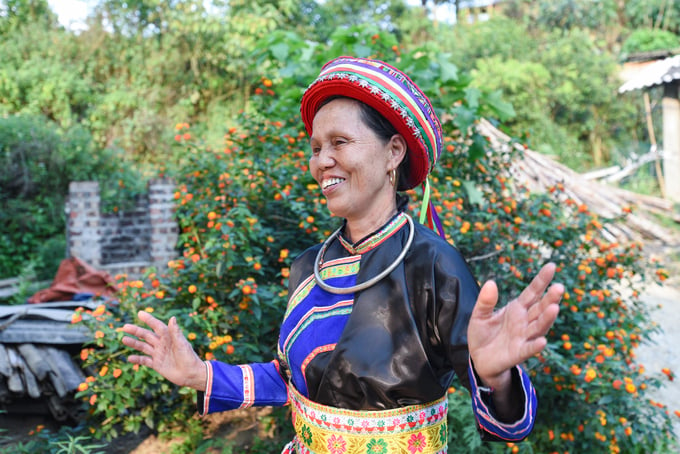
Secretary of the Party Branch of Phieng Phan village, Trieu Thi Man could not hide her joy when sharing about the locality. Photo: Tung Dinh.
Like many other Dao villages, Phieng Phan village is perched on top of the mountain. According to locals, the climate here is pleasant all year round. The village has 42 households and 57 people, all of whom are ethnic Que Lam Dao people, who discovered this land and settled hundreds of years ago.
In the past, Phieng Phang was the most difficult upland village of Yen Duong commune. Traffic was hindered, people engaging in agroproduction mainly in the direction of self-sufficiency, so the poverty rate was high.
In recent years, thanks to the attention of the Party Committee and local authorities, the Que Lam Dao people in Phieng Phang have gradually changed their mindset. It's still the same rice plant and black chung cake, with a little work on marketing, now they can sell it directly to tourists in the village without having to transport it far away.
We have the opportunity to experience many community tourism village from North to South, and almost every place have this one thing in common: The local "guides" are mainly young people - those with basic training. They have knowledge of foreign languages as well as familiarity with customs, lowland culture. They are exceptionally agile, enough to lead guests around. Phieng Phan people are among the few that do not fall into that category.
From the moment we arrived at the beginning of the village to the time we said goodbye to the terraced rice fields, we were all welcomed by aunts and grandmothers. Looking at how quickly and boldly they invited guests, we wondered how much Phieng Phang had to change to get rid of the inherent shyness of the mountain people.
But perhaps the most special thing was still the smiles. Whether sitting in the hot kitchen and watching the pot of cakes being boiled or when teaching the technique of knitting baskets, the Dao people in Phieng Phang were still as gentle as a cloud floating over Pu Lau peak. They dedicatedly and patiently told the stories again and again even when guests did not understand. The smiles were still there, like a promise for hundreds of years by the Phja Bjooc mountain range.
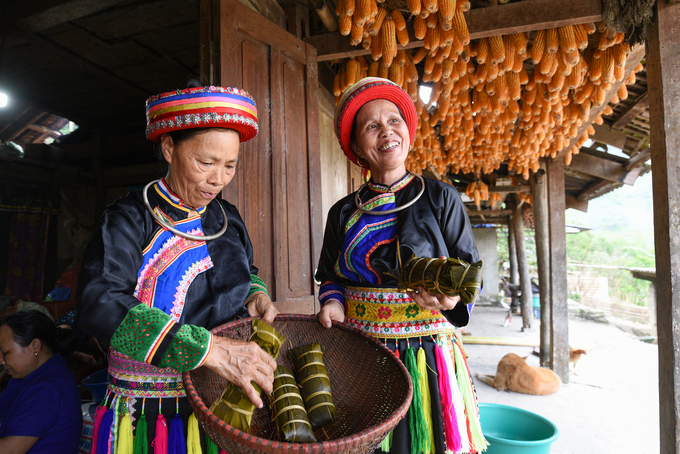
Que Lam Dao women introduce black Chung cake to visitors. Photo: Tung Dinh.
Since the inter-village road Na Pai - Phieng Phang was concreted and expanded, people in Phieng Phang have more conditions for economic development, improving their material and mental life.
“You have to fill your belly first to get to work,” Trieu Thi Dao said. Quickly climbing into the passenger seat to lead the way, she told about her over 2 ha Phyllostachys bamboo forest on the top of the slope, which is closely linked with her son's sturgeon pond to create a resort for tourists.
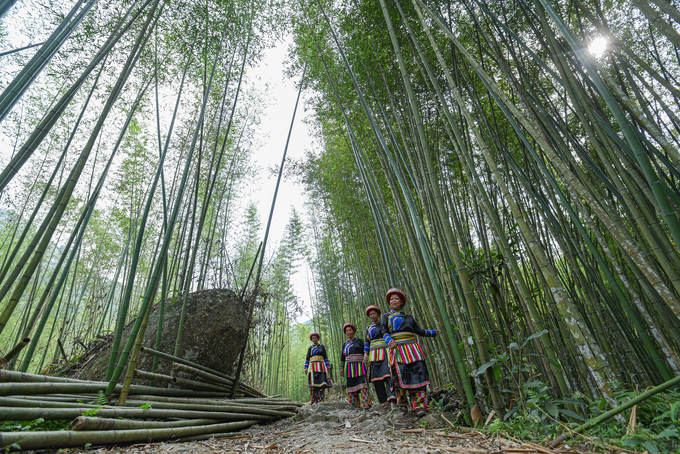
The scene in the Phyllostachys bamboo forest on the top of Pu Lau. Photo: Tung Dinh.
Just a few years ago, Phyllostachys bamboo in this forest was mainly for commercial purposes. However, the selling price was not high. Traders often went to the forest, only choosing big and firm trees to harvest every 3-4 years. More than 2 ha only gave Man an income of roughly VND 10 million.
"It's not worth it, uncle," Dao said. And as proof, she pointed to a large pile of freshly cut bamboo, preparing to build a house, tables, chairs, ready to make a swing, bridge, and many more for tourists to take "check-in" pictures. Dao knew how to develop a value chain as she linked with her son to open a bamboo forest resort in combination with enjoying sturgeon and salmon. She understood that there is nothing better than actively looking for the output of her product. Instead of waiting for traders to come, she kept the bamboo tree with Phieng Phang. It was no longer the bamboo tree that she sold, but intangible values and unique cultural features.
In addition to being a tourist attraction, the bamboo forest is currently a place that provides an abundant source of raw materials for the traditional knitting craft of the local Que Lam Dao people, creating jobs and increasing income, especially for women. Traditional handicraft products such as baskets, mats, nong, nia of the Dao ethnic group in Na Pai and Phieng Phang villages are now restored, becoming commodities, bringing a significant source of income for the local people.
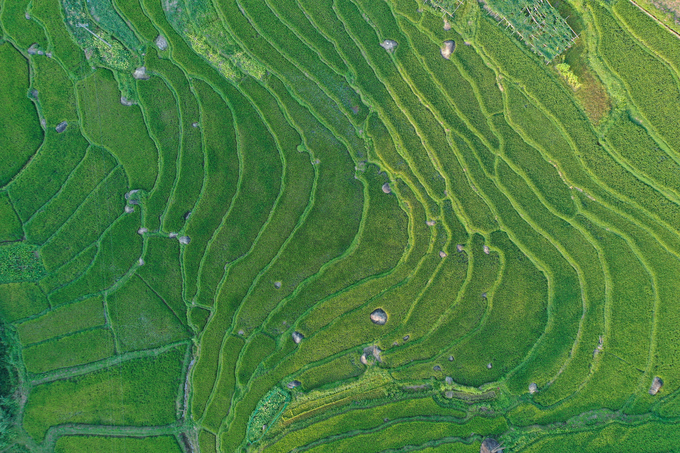
The lush green fields on Pu Lau. Photo: Tung Dinh.
While we were enjoying the full beauty of Phieng Phang, Trieu Thi Man returned. She wore the traditional costume of the Dao people. It had sophisticated designs, patterns, and textures which bore the essence of nature, flowers, and the forest.
Excited to introduce each souvenir photo placed at the village's cultural house, Man said that the most joyous thing now was to see everyone in the village had a sense of community tourism, and at the same time knew how to apply science and technology in farming to improve productivity, stabilize livelihoods, no longer having days without a belly full like before. The terraced fields not only brought rice and corn but also became an important factor to attract visitors, bringing higher value to the Dao people on the top of Pu Lau.
Translated by Samuel Pham
/2025/05/25/4127-3-073637_820.jpg)
(VAN) Thanks to the promotion from an FAO-implemented project, vegetable production in greenhouses in Moc Chau has seen strong development, from 1.5 hectares in 2021 to nearly 50 hectares in 2024.
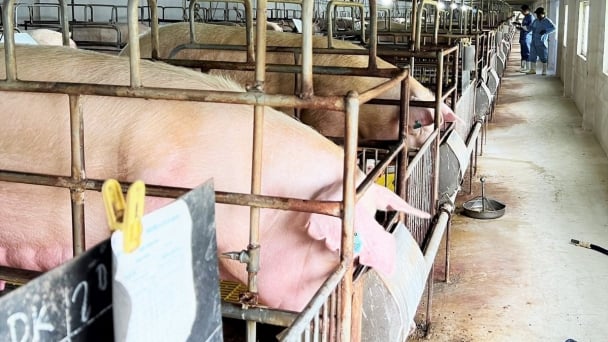
(VAN) FAO has recently supported USD 140,000 to implement the project 'Risk mitigation human-animal interface risks through disease control initiatives in pig farming.'

(VAN) The People's Committee of Tra Vinh province has approved an adjustment to the investment policy for the Green Hydrogen Plant project, increasing its area to approximately 52.76 hectares.
![Reducing emissions from rice fields: [2] Farmers’ commitment to the soil](https://t.ex-cdn.com/nongnghiepmoitruong.vn/608w/files/news/2025/05/05/dsc08881jpg-nongnghiep-140632.jpg)
(VAN) Clean rice cultivation model in Thuong Tan commune, Bac Tan Uyen district, is assisting local residents in achieving sustainable agriculture by substantially reducing costs, increasing productivity, and protecting the environment.
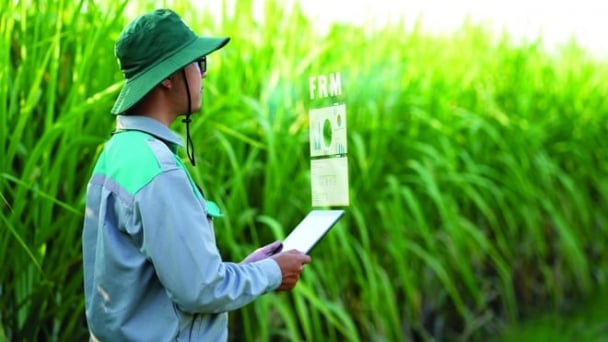
(VAN) At the conference to disseminate Resolution No. 68, AgriS introduced its digital agricultural ecosystem and reaffirmed its commitment to accompanying the Government in promoting private sector development and sustainable agriculture.
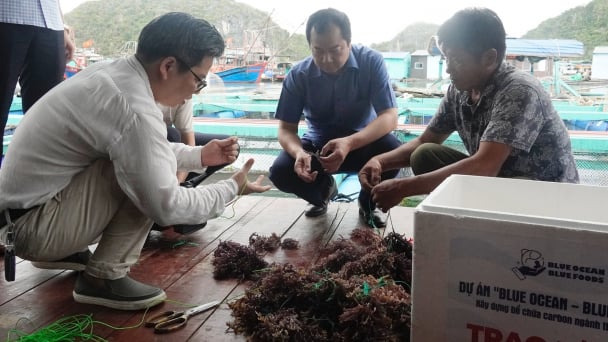
(VAN) 'Blue Ocean - Blue Foods' initiative is designed to restore marine ecosystems and establish sustainable livelihoods for local communities by cultivating a minimum of 1,000 hectares of cottonii seaweed in the first three years.
/2025/05/21/4642-3-112707_603.jpg)
(VAN) The V-SCOPE project has made direct contributions to three out of six pillars of the Comprehensive Strategic Partnership between Vietnam and Australia.